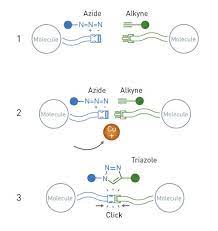Carolyn Bertozzi’s “Click Chemistry” for Mapping Cell Functions

2022 Nobel Prize Click Chemistry
Three days ago, the Nobel Prize Committee awarded one third of the 2022 Chemistry Prize to Carolyn Bertozzi, HHMI Investigator at Stanford University. All three winners shared in the discovery of “click chemistry,” but Bertozzi’s role was in using this technique for following labeled cells in the body without interfering with their biological processes. From her HHMI biosketch: “Carolyn Bertozzi uses chemical tools to study biological processes. Bertozzi and her team’s research initially focused on the study of cell surface sugars, including glycolipids and glycoproteins. To image these sugars with microscopes, the team developed a tool called bioorthogonal chemistry which relies on pairs of chemical groups that want to react and form a bond with each other. Bioorthogonal refers to the fact that these partners do not interact or interfere with biology. Using the spotlight of bioorthogonal chemistry, the team revealed an as-yet-unknown cell surface sugar – glycoRNA. This approach is now used to study molecules such as proteins, DNA, and RNA in live cells and has potential utility as a drug delivery system for cancer therapeutics.” The inked diagram of how this works shows an elegantly simple means following cells’ traffic patterns. MORE
Image Credit: ChemistryWorld.com


